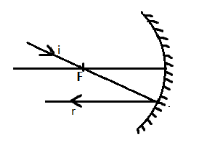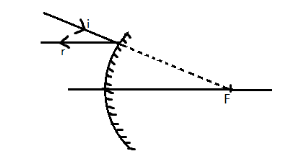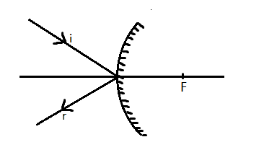
Draw the following diagram, in which a ray of light is incident on a concave/ convex mirror, in your answer sheet. Show the part of this ray, after reflection, in each case.


Answer
534.9k+ views
Hint: We have concave as well as convex mirror in the above questions. We can simply draw it by following the rules. Some of the rules are mentioned below.
Complete step-by-step answer:
Let us start with the concave mirror given in figure 1.
For concave mirrors, any incident ray travelling parallel to the principal axis on the way to the mirror will pass through the focal point upon reflection. Any incident ray passing through the focal point on the way to the mirror will travel parallel to the principal axis upon reflection.

But in case of convex mirror:
When a ray strikes concave or convex mirrors obliquely at its pole, it is reflected obliquely. When a ray, parallel to the principal axis strikes concave or convex mirrors, the reflected ray passes through the focus on the principal axis. Also, when the ray passes through focus strikes concave or convex mirrors, the reflected ray will pass parallel to the principal axis.

And similarly, the next diagram for convex mirror:

Thus, all the ray diagrams are obtained.
Additional Note: A mirror is a reflective surface that bounces off light-producing either a real image or a virtual image. When an object is placed in front of a mirror, the image of the same object is seen in the mirror. The object is the source of the incident rays and the image is formed by the reflected rays.
Ray diagrams help us trace the path of the light for the person to view a point on the image of an object. It uses lines with arrows to represent the incident ray and the reflected ray. It also helps us trace the direction in which the light travels.
Note: A concave mirror, or converging mirror, has a reflecting surface that is recessed inward (away from the incident light). Concave mirrors reflect light inward to one focal point. They are used to focus light. Concave mirrors can produce both real and virtual images; they can be upright (if virtual) or inverted (if real); they can be behind the mirror (if virtual) or in front of the mirror (if real); they can also be enlarged, reduced, or the same size as object. A convex mirror is also known as a diverging mirror as this mirror diverges light when they strike on its reflecting surface.
Complete step-by-step answer:
Let us start with the concave mirror given in figure 1.
For concave mirrors, any incident ray travelling parallel to the principal axis on the way to the mirror will pass through the focal point upon reflection. Any incident ray passing through the focal point on the way to the mirror will travel parallel to the principal axis upon reflection.

But in case of convex mirror:
When a ray strikes concave or convex mirrors obliquely at its pole, it is reflected obliquely. When a ray, parallel to the principal axis strikes concave or convex mirrors, the reflected ray passes through the focus on the principal axis. Also, when the ray passes through focus strikes concave or convex mirrors, the reflected ray will pass parallel to the principal axis.

And similarly, the next diagram for convex mirror:

Thus, all the ray diagrams are obtained.
Additional Note: A mirror is a reflective surface that bounces off light-producing either a real image or a virtual image. When an object is placed in front of a mirror, the image of the same object is seen in the mirror. The object is the source of the incident rays and the image is formed by the reflected rays.
Ray diagrams help us trace the path of the light for the person to view a point on the image of an object. It uses lines with arrows to represent the incident ray and the reflected ray. It also helps us trace the direction in which the light travels.
Note: A concave mirror, or converging mirror, has a reflecting surface that is recessed inward (away from the incident light). Concave mirrors reflect light inward to one focal point. They are used to focus light. Concave mirrors can produce both real and virtual images; they can be upright (if virtual) or inverted (if real); they can be behind the mirror (if virtual) or in front of the mirror (if real); they can also be enlarged, reduced, or the same size as object. A convex mirror is also known as a diverging mirror as this mirror diverges light when they strike on its reflecting surface.
Recently Updated Pages
Master Class 12 English: Engaging Questions & Answers for Success

Master Class 12 Business Studies: Engaging Questions & Answers for Success

Master Class 12 Economics: Engaging Questions & Answers for Success

Master Class 12 Social Science: Engaging Questions & Answers for Success

Master Class 12 Maths: Engaging Questions & Answers for Success

Master Class 12 Chemistry: Engaging Questions & Answers for Success

Trending doubts
What are the major means of transport Explain each class 12 social science CBSE

Which are the Top 10 Largest Countries of the World?

Draw a labelled sketch of the human eye class 12 physics CBSE

Explain sex determination in humans with line diag class 12 biology CBSE

The pH of the pancreatic juice is A 64 B 86 C 120 D class 12 biology CBSE

Explain sex determination in humans with the help of class 12 biology CBSE




